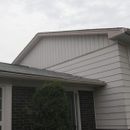Condensation and insulation
I insulated my attic with cellulose a few years ago. But before I did, I sealed all gaps using Great Stuff. Yesterday, I had to go in my attic to change the position of a ceiling light, and when I moved insulation out of the way, I realized that the plywood wall and insulation touching it were all wet. But there was no sign of water leaking in the plywood above the cellulose line.
If you look at the picture, the attic starts at the bottom of the vertical siding.
I asked a guy at Home Depot, and he believes that the condensation is due to cold air coming in under the aluminium siding and hitting the warmer plywood touching the cellulose.
Does it make sense? How do I fix my attic wall? Should I put a vapour barrier so that the plywood doesn’t touch the cellulose? Will that help?
Thanks!
GBA Detail Library
A collection of one thousand construction details organized by climate and house part










Replies
> cold air coming in under the aluminium siding and hitting the warmer plywood
It's the opposite that causes condensation. How is the attic ventilated?
Soffit vents, ridge vents, and maxi vents.
That's a big exposed gable end. I'd guess that there is a problem with flashing or lack of weather barrier where the vertical siding and horizontal meet. Insulation is not allowing the leak to dry out, that's why plywood above is dry. Or, it ran down the wall, dried quickly but won't dry in the cellulose.
Marc,
Jon is right: condensation occurs when warm air contacts a cold surface. It does not occur when cold air contacts a warm surface.
The cause of the condensation you see is almost undoubtedly air leaks that allow warm, conditioned air into the attic. Get a flashlight and look closely at the base of the gable-end studs in your attic. Somewhere near your attic floor, there are cracks -- air leaks that allow warm air to rise to your attic. You need more caulk or canned spray foam.
If the gable is created with balloon framing -- continuous studs that extend from the first floor into your attic -- then you need to install rectangular pieces of blocking, each carefully sealed, between each stud at the level of your attic floor.
Thanks Martin. Yes, I think that I didn't foam the gable-end studs. Will have to go back in the attic and fix it....
Marc,
More information here: "Why Is My Attic Damp?"
Sounds like another case of air sealing without a blower door test being ineffective.